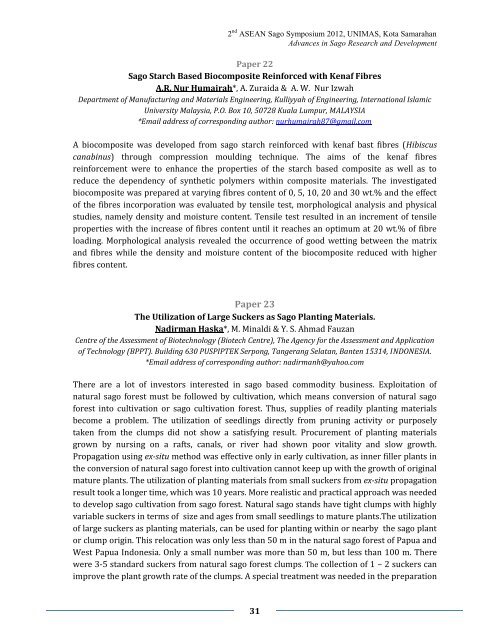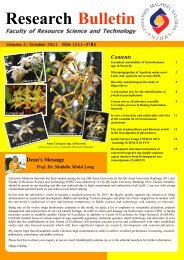2nd ASEAN Sago Symposium 2012, UNIMAS, Kota Samarahan ...
2nd ASEAN Sago Symposium 2012, UNIMAS, Kota Samarahan ...
2nd ASEAN Sago Symposium 2012, UNIMAS, Kota Samarahan ...
You also want an ePaper? Increase the reach of your titles
YUMPU automatically turns print PDFs into web optimized ePapers that Google loves.
2 nd <strong>ASEAN</strong> <strong>Sago</strong> <strong>Symposium</strong> <strong>2012</strong>, <strong>UNIMAS</strong>, <strong>Kota</strong> <strong>Samarahan</strong><br />
Advances in <strong>Sago</strong> Research and Development<br />
Paper 22<br />
<strong>Sago</strong> Starch Based Biocomposite Reinforced with Kenaf Fibres<br />
A.R. Nur Humairah*, A. Zuraida & A. W. Nur Izwah<br />
Department of Manufacturing and Materials Engineering, Kulliyyah of Engineering, International Islamic<br />
University Malaysia, P.O. Box 10, 50728 Kuala Lumpur, MALAYSIA<br />
*Email address of corresponding author: nurhumairah87@gmail.com<br />
A biocomposite was developed from sago starch reinforced with kenaf bast fibres (Hibiscus<br />
canabinus) through compression moulding technique. The aims of the kenaf fibres<br />
reinforcement were to enhance the properties of the starch based composite as well as to<br />
reduce the dependency of synthetic polymers within composite materials. The investigated<br />
biocomposite was prepared at varying fibres content of 0, 5, 10, 20 and 30 wt.% and the effect<br />
of the fibres incorporation was evaluated by tensile test, morphological analysis and physical<br />
studies, namely density and moisture content. Tensile test resulted in an increment of tensile<br />
properties with the increase of fibres content until it reaches an optimum at 20 wt.% of fibre<br />
loading. Morphological analysis revealed the occurrence of good wetting between the matrix<br />
and fibres while the density and moisture content of the biocomposite reduced with higher<br />
fibres content.<br />
Paper 23<br />
The Utilization of Large Suckers as <strong>Sago</strong> Planting Materials.<br />
Nadirman Haska*, M. Minaldi & Y. S. Ahmad Fauzan<br />
Centre of the Assessment of Biotechnology (Biotech Centre), The Agency for the Assessment and Application<br />
of Technology (BPPT). Building 630 PUSPIPTEK Serpong, Tangerang Selatan, Banten 15314, INDONESIA.<br />
*Email address of corresponding author: nadirmanh@yahoo.com<br />
There are a lot of investors interested in sago based commodity business. Exploitation of<br />
natural sago forest must be followed by cultivation, which means conversion of natural sago<br />
forest into cultivation or sago cultivation forest. Thus, supplies of readily planting materials<br />
become a problem. The utilization of seedlings directly from pruning activity or purposely<br />
taken from the clumps did not show a satisfying result. Procurement of planting materials<br />
grown by nursing on a rafts, canals, or river had shown poor vitality and slow growth.<br />
Propagation using ex-situ method was effective only in early cultivation, as inner filler plants in<br />
the conversion of natural sago forest into cultivation cannot keep up with the growth of original<br />
mature plants. The utilization of planting materials from small suckers from ex-situ propagation<br />
result took a longer time, which was 10 years. More realistic and practical approach was needed<br />
to develop sago cultivation from sago forest. Natural sago stands have tight clumps with highly<br />
variable suckers in terms of size and ages from small seedlings to mature plants.The utilization<br />
of large suckers as planting materials, can be used for planting within or nearby the sago plant<br />
or clump origin. This relocation was only less than 50 m in the natural sago forest of Papua and<br />
West Papua Indonesia. Only a small number was more than 50 m, but less than 100 m. There<br />
were 3-5 standard suckers from natural sago forest clumps. The collection of 1 – 2 suckers can<br />
improve the plant growth rate of the clumps. A special treatment was needed in the preparation<br />
31



